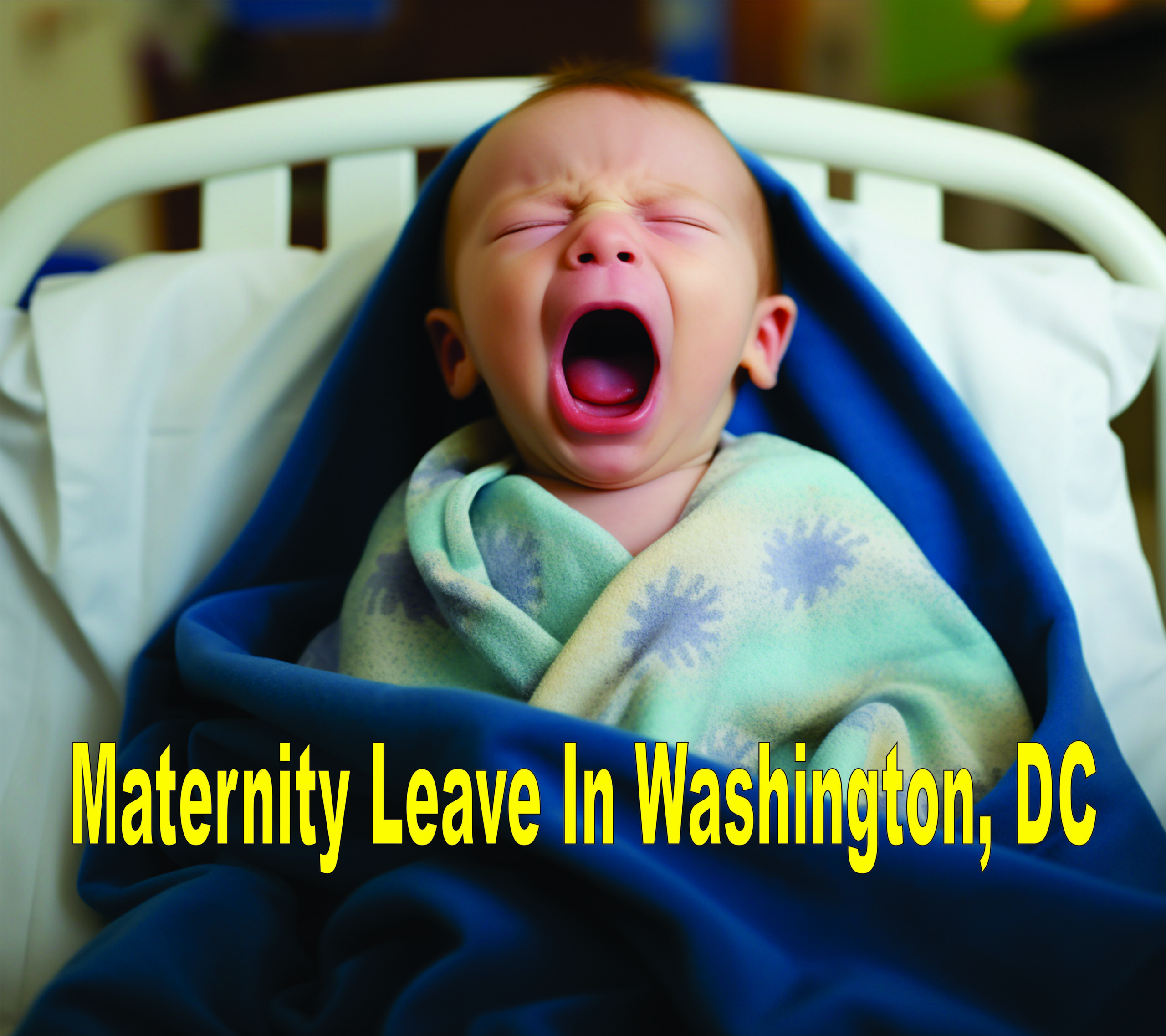Last Updated on January 29, 2024 by Lori Pace
Workers in Washington, DC now have paid family and maternity leave. This is good news for both its residents as well as those who live nearby (like Maryland and Virginia) and allows them to still receive the benefit. The Universal Paid Leave Amendment Act, (UPLAA) made the program effective on July 1, 2020.
Washington DC Maternity Leave
How many weeks of paid maternity leave do I get?
The Universal Paid Leave Amendment Act (UPLAA) offers up to eight weeks of parental leave, whether it’s for maternity or paternity. During this time, new parents can partially receive their salary while bonding with their children. It’s worth noting that before this, DC’s family law only granted 16 weeks of unpaid leave. However, if the eight weeks of paid leave are used up, employees still have the option to take an additional eight weeks of unpaid time.
Who qualifies for paid family leave?
Anyone who resides in any state except DC and is employed by a private sector company based in Washington, DC, is eligible for the paid family leave law.
It’s essential to note that federal government employees based in DC are not eligible for the paid family leave offered by the city. However, if you reside in Bethesda and commute to Washington, you are eligible to benefit from DC’s paid family leave law. Conversely, if you live outside Bethesda and commute to DC, you may not use the DC paid leave law. On a positive note, as of October 1, 2020, federal employees across the nation, encompassing 2.1 million workers, were granted 12 weeks of paid parental leave.
Remote workers are eligible for the family leave benefit, granted they perform the same work at home as they would in the office. DC Councilmember Elissa Silverman emphasized that remote workers who qualify would be regarded as employees of the DC office, ensuring they can access the benefit.
The Government Family Leave Program Amendment Act of 2014 provides a valuable paid alternative for District Government employees. Since October 2014, all eligible government employees have been entitled to take up to 8 weeks of paid family leave within a 12-month period. This benefit can be used to care for a newborn child or a family member in need.
Part-time workers and employees who have worked for their DC employers for at least 52 weeks before the law’s implementation are eligible for paid family leave. Additionally, I can attest that even if your employment period has been brief and you switch between different DC employers, you are still eligible for the valuable benefit of paid family leave.
Self-employed workers have the right to participate in this beneficial program. After opting in, you become eligible for benefits within the first year. For those considering opting in, it’s essential to know that quarterly contributions equal to 0.62% of your self-employment income are required. This contribution percentage aligns with what DC businesses pay for their employees, ensuring fairness and equity.
How much will I be paid?
The payment structure is designed to support workers with varying income levels. If you earn up to one and a half times the minimum wage or $46,800 per year in July 2020, you are eligible for 90% of your wages while on leave. For those earning between $46,800 and $61,700, the benefit is between 84% and 90% of your annual wages. Moreover, workers earning more than $61,700 per year can receive a maximum benefit of $1,000 per week. This tiered payment approach ensures that the benefit caters to the needs of different income brackets.
Can I take paid family leave for something other than a new baby?
The DC law recognizes various scenarios where paid family leave can be utilized. Besides using it for a new baby, the law allows for different amounts of time off. For instance, you can take six weeks of family time to care for ill relatives or use two weeks for medical leave to attend to your serious health condition. The rates of payment remain consistent across these scenarios, ensuring fair support for different family and health needs.
Can I take more than eight weeks off?
Yes, but with some caveats. The DC Family and Medical Leave Act provides 16 weeks of unpaid vacation for employees in the private sector who are located in DC and have more than 20 employees. It’s not paid leave but employees can keep their jobs and benefits. The DCFMLA allows you to take 16 weeks off. However, DC PFL only pays for eight weeks. You would receive two to six weeks of paid time if you were caring for someone else or your loved one.
Federal-government employees and people who reside in DC but work in other states are not covered by the DCFMLA. Federal-government employees and some employees in the private sector are covered by the National Family and Medical Leave Act. This law provides for 12 weeks of unpaid time to care for oneself or a family member, as well as a newborn baby.
Do I need to use all my leave at once?
No, you do not. You have the flexibility to manage your leave duration. The leave can be taken for up to 12 months from the date of the qualifying event, and you are not required to use all the leave at once. However, it’s crucial to remember that within a 12-month period, you can only take a maximum of eight weeks of leave. For example, if you take eight weeks of leave for giving birth, you will not be eligible for additional weeks for illness within the same 12-month period.
What about my spouse?
It’s important to understand that both partners may be eligible for paid family leave if they meet the requirements. If your spouse works for a private-sector company based in DC, they can avail themselves of the benefit. However, it’s essential to note that eligibility for one spouse does not automatically extend to the other; each spouse must meet the individual eligibility criteria to qualify for the benefit.
What if I foster, adopt, or use a surrogate? Are those qualifying events?
Fostering a child, adopting a child, or having a child through surrogacy are qualifying events for the family leave benefit. Regardless of the method used to welcome a child into your family, you are entitled to access paid family leave to support and bond with your new family member.
Who is included in taking time off for family members?
It’s important to know that the DC family leave policy covers a broad range of relationships. You may take time off to care for a biological, adoptive, or foster child, as well as stepchildren. Additionally, you are eligible to care for individuals to whom you stand as a parent or those related to you by domestic marriage or domestic partnership. The benefit extends to adult-in-laws, adult stepparents, or anyone who acted in loco parentis when you were a child. Moreover, you can take time off to care for individuals related to you by blood or marriage, including grandparents.

How is the benefit paid for?
As a beneficiary of the family leave benefit, it’s important to understand how the plan is funded. Employers are responsible for paying into the program, which means no taxes are deducted from your paycheck unless you are self-employed and opt into the program. Since July 1, 2019, private-sector employers have been contributing an additional 0.62% employer payroll tax for each quarter, ensuring adequate funding for the benefit. It’s reassuring to note that the tax rate for employees will not increase.
If my company pays for some portion of leave, can I combine it with UPLAA to receive 100 percent of my salary?
The decision lies with your employer. In general, DC pays the first part of the paid leave benefit. However, some employers offer the option to ‘top-off’ the benefit by providing additional time off or salary. This flexible approach allows employees to receive additional support beyond what is covered by the government program, depending on their employer’s policies.
Employers are not obligated to offer benefits beyond the paid leave provided by DC law. Workplace lawyer Tom Spiggle rightly points out that while some employers may choose to provide additional benefits, they cannot replace the essential support that paid leave offers. The Family and Medical Leave Act does not mandate employers to offer benefits beyond the stipulated paid leave.
As a DC resident who has followed the policymakers’ statements, Councilmember Elissa Silverman clarifies that the primary aim of the family leave policy is not to penalize good employers. Instead, the goal is to establish a basic benefit accessible to all eligible individuals. This benefit provides essential support to employees during significant life events. Employers who wish to go above and beyond this basic benefit are encouraged to do so, fostering an environment of understanding and support for families in the workforce.
If my employer currently offers six weeks of paid leave, and DC now offers eight, can I combine the two?
It’s essential to understand the options available. With DC now offering eight weeks of paid leave, you may wonder if you can combine it with your employer’s current policy of six weeks. The answer is yes, you can combine the two benefits. DC will pay the first eight weeks at full salary, with a $1,000 weekly cap. If you earn more than $1,000 per week, your employer may offer an additional fee for the remaining six weeks. However, to utilize all 14 weeks, your employer must have a policy that provides six additional weeks to supplement the eight weeks provided by DC.
Do I have to take leave in full-week increments?
No. When you apply, you only have to indicate if you’re going to take the leave on a full-time, continuous schedule, or a part-time, intermittent schedule.
Is the leave pay taxed?
Yes. According to the website of the program, the benefits are tax-deductible and included in your gross income for the District and federal government. The District will send you a 1099-G form reporting all payments received in the past year. For information on the taxability of benefits, contact your state tax agency if you are not in the District.
What do I have to do to get the money? How am I paid?
The DC Office of Paid Family Leave can be applied online. You will need to submit proof for parental leave claims. This could include a birth certificate, adoption papers, or other documentation. The website provides a complete list of information and proof types that you can submit for each type. If your claim has been approved, you will be notified within 10 days. You’ll then receive your money in biweekly installments.
Are there any monetary caps on the benefit annually or during one’s lifetime?
There is no lifetime limit; the annual cap for a 12-month period is $1,000 per week, eight weeks.
Do I still receive my benefits while I’m out?
Similar to FMLA, you can take time off, and your job, and benefits, are protected. Employers with less than 20 employees are not eligible for job protection.
Where do I go if I have more questions?

The DC Office of Paid Family Leave website has a lot of information. You can reach the office by email or by phone at (202) 899-3700.

